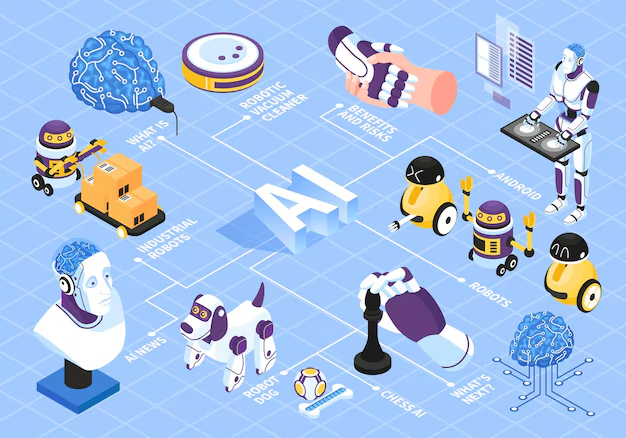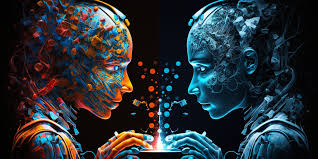Introduction
Artificial intelligence (AI) is no longer a futuristic concept; it’s a present reality transforming industries and redefining the way we live and work. From autonomous vehicles to personalized medicine, AI is driving innovation and creating new possibilities. In this blog post, we will explore the future of AI, discussing key trends, challenges, and opportunities that lie ahead.
The Evolution of Artificial Intelligence
Early Beginnings
AI’s journey began in the 1950s with pioneers like Alan Turing, who laid the groundwork for modern computing and machine learning. Early AI research focused on problem-solving and symbolic methods, leading to the development of expert systems in the 1970s and 1980s.
Machine Learning and Big Data
The advent of machine learning in the late 1990s marked a significant shift. Unlike traditional AI, which relied on predefined rules, machine learning enabled systems to learn from data. The rise of big data and advancements in computational power have further accelerated AI development, allowing for more sophisticated models and applications.
Deep Learning and Neural Networks
In recent years, deep learning and neural networks have revolutionized AI. These models, inspired by the human brain, excel at recognizing patterns and making predictions. They have been instrumental in breakthroughs like natural language processing (NLP), image recognition, and autonomous systems.
Current Trends in Artificial Intelligence
Natural Language Processing
Natural language processing (NLP) enables machines to understand and interact with human language. Advances in NLP have led to the development of virtual assistants like Siri, Alexa, and Google Assistant, which can comprehend and respond to complex queries. NLP is also transforming customer service, content creation, and sentiment analysis.
Autonomous Systems
Autonomous systems, including self-driving cars and drones, are becoming increasingly sophisticated. Companies like Tesla, Waymo, and Uber are leading the charge in developing vehicles that can navigate and make decisions without human intervention. These technologies promise to revolutionize transportation, logistics, and delivery services.
AI in Healthcare
AI is making significant strides in healthcare, from diagnostic tools to personalized treatment plans. Machine learning models can analyze medical images with remarkable accuracy, helping doctors detect diseases early. AI-powered systems also enable personalized medicine by analyzing genetic data and predicting patient responses to treatments.
AI and Cybersecurity
As cyber threats become more complex, AI is playing a crucial role in enhancing cybersecurity. AI-driven systems can detect anomalies, identify potential threats, and respond to attacks in real-time. This proactive approach helps organizations protect sensitive data and maintain robust security measures.
Challenges Facing Artificial Intelligence
Ethical and Social Implications
AI raises several ethical and social concerns, including privacy, bias, and job displacement. Ensuring that AI systems are transparent, fair, and accountable is critical. Policymakers, researchers, and industry leaders must collaborate to establish ethical guidelines and address these challenges.
Data Privacy
AI relies on vast amounts of data to function effectively. However, the collection and use of personal data raise significant privacy concerns. Ensuring that data is collected and used responsibly, with individuals’ consent, is essential to maintaining public trust.
Bias in AI Models
AI models can inadvertently learn and perpetuate biases present in training data. This can lead to unfair and discriminatory outcomes, particularly in areas like hiring, lending, and law enforcement. Developing techniques to identify and mitigate bias in AI systems is a priority for researchers and developers.
Job Displacement
The automation of tasks previously performed by humans raises concerns about job displacement. While AI creates new opportunities, it also disrupts traditional employment patterns. Reskilling and upskilling the workforce are essential to ensuring that individuals can adapt to the changing job landscape.
Opportunities for Growth and Innovation
AI in Business
Businesses across industries are leveraging AI to optimize operations, enhance customer experiences, and drive innovation. From predictive analytics to customer service chatbots, AI solutions are helping companies gain a competitive edge. Investing in AI technologies can lead to increased efficiency, cost savings, and revenue growth.
Education and Training
AI has the potential to revolutionize education and training. Adaptive learning systems can personalize educational content based on individual needs, improving learning outcomes. AI-powered tools can also assist educators by automating administrative tasks and providing insights into student performance.
AI in Environmental Sustainability
AI can contribute to environmental sustainability by optimizing resource usage, reducing waste, and enhancing conservation efforts. For example, AI models can analyze climate data to predict weather patterns and inform disaster response strategies. In agriculture, AI-driven systems can optimize irrigation and pest control, promoting sustainable farming practices.
Research and Development
AI is a powerful tool for advancing scientific research and development. It can accelerate the discovery of new materials, drugs, and technologies by analyzing vast datasets and identifying patterns. Collaborations between AI researchers and domain experts can lead to groundbreaking innovations that address global challenges.
The Future of Artificial Intelligence
The future of AI is both exciting and uncertain. As AI continues to evolve, it will undoubtedly transform industries and create new opportunities. However, addressing the ethical, social, and technical challenges is crucial to ensuring that AI benefits society as a whole.
Collaboration and Regulation
Collaboration between governments, academia, and industry is essential to the responsible development and deployment of AI. Establishing clear regulations and ethical guidelines will help mitigate risks and ensure that AI is used for the greater good.
Continuous Learning and Adaptation
The rapid pace of AI development requires continuous learning and adaptation. Businesses, policymakers, and individuals must stay informed about the latest advancements and be prepared to adapt to new realities. Lifelong learning and flexibility will be key to thriving in an AI-driven world.
Conclusion
Artificial intelligence holds immense potential to drive innovation, enhance efficiency, and address global challenges. By understanding the trends, challenges, and opportunities in AI, we can harness its power responsibly and effectively. At TechSage, we are committed to providing insights and guidance to help you navigate the exciting world of AI. Stay tuned for more in-depth analysis and expert advice on the latest trends in technology.





Leave a Reply